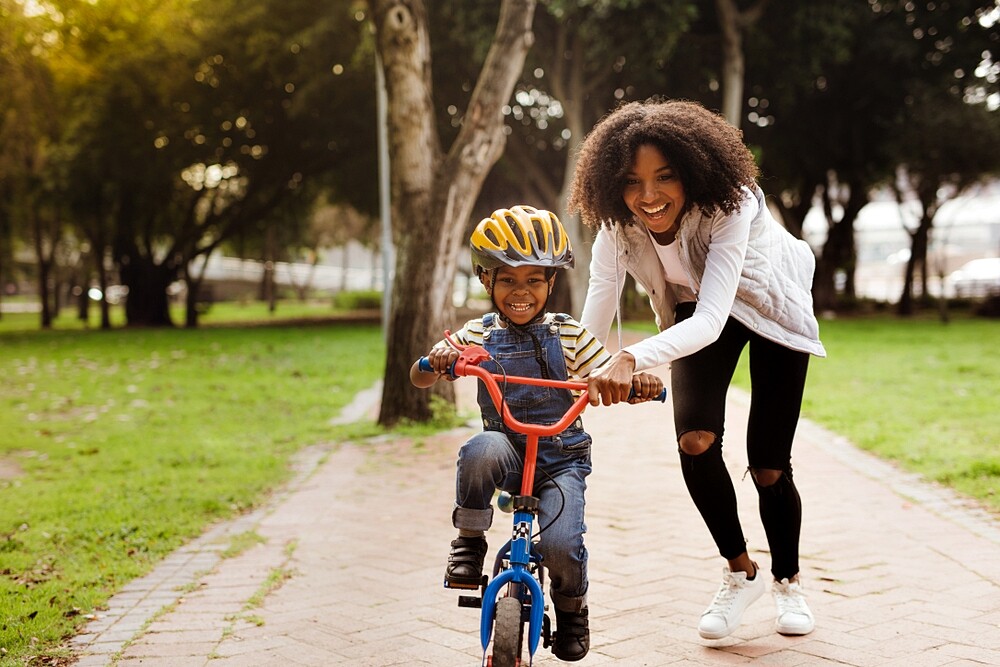You want to learn to ride a bike with your child? We will show you what is important and what you need to know.
Learning to ride a bike: When is the right time?
- If you want to teach your child to ride a bike, you might ask yourself the question: When is the right time to do so? As is often the case, there is no universal answer, as each child grows up differently and has its own pace of learning new skills.
- Cycling requires coordination and good motor skills. It is therefore naturally also the responsibility of the parents to develop a feeling for when they think it is right to put the child on the bike. Especially in traffic, false ambition can quickly become dangerously noticeable.
- In today’s achievement-oriented society, where children learn foreign languages in kindergarten, many of them also start to practice cycling at a very early age. Children between the ages of 1-2 years use running bikes and thus learn to control their balance and steer the bike. This is a good basis for practicing cycling later.
Learning to ride a bike: Preparation
- In addition to wheels, scooters are also well suited to develop motor skills and get a feeling for time and space.
- Support wheels should be avoided from the beginning. Support wheels simulate a feeling of security that will not be there later. As a result, they can even make cycling more difficult. It is better to wait a little longer until the child can learn to ride a bicycle.
Learn to ride a bike: The right bike
- Safety: It is important that the bicycle is safe, i.e. that the brakes work, closed chain guard etc. It is not at all a question of whether there are enough reflectors on the bike or whether the bell is loud enough. These are things that can be adjusted if the child can ride the bike freely.
- Bicycle helmet: It is important and sensible to get the child used to wearing a bicycle helmet immediately. In this way he or she is safe from the start and automatically connects the bicycle helmet to the bike. Later it is much more difficult to get used to it.
- Settings: The saddle and handlebars must be correctly adjusted for cycling so that the child can ride properly. The saddle should be adjusted so that the feet can still touch the ground. They do not have to touch the ground completely, but at least the balls of the feet should maintain secure contact with the ground. The handlebars should also be adjusted to a height that allows relatively upright riding and also ensures that the brakes are applied quickly. For this purpose the elbows can be slightly bent.
Learning to ride a bike: The right place
Of course, nobody should ride directly in traffic to learn how to ride a bike. However, the following places are suitable for taking your first steps on a bike.
- Parking spaces: After the opening hours of the shops, parking lots are a good place to park, as they offer plenty of space and nobody else will show up.
- Parks: Parks are also usually very spacious and especially during the week or in the evening there should not be too much activity. Nevertheless, pay attention that one does not necessarily drive over the invested lawn areas.
- Property: For all those who enjoy the luxury of their own property, the own yard or garden is of course a good choice.
Learn to ride a bike: 5 tips for practice
- Starting up: Starting up is the first and usually the most difficult hurdle in practice. In contrast to driving, there are no stabilizing forces acting yet. You can support the child by giving it a short push and making it roll.
- Falling: No master has ever fallen from heaven. The first fall comes faster than expected and therefore it is important to learn about falling in advance. By wearing knee and elbow protectors the risk of injury can be minimized. Especially at low speed you should allow the fall to happen and not always intervene, otherwise a deceptive safety will creep in, which will not be there later on.
- Looking forward: To keep your balance as well as possible, you should look forward while cycling. Upper body and head form a line. To avoid distractions, parents should walk in front of the bike and not behind it.
- Practice braking before: The brakes provide a safe feeling and therefore they should be tested before riding. The bike can also be converted into a scooter by unscrewing one of the pedals. This gives the child a good feeling for the bike and also allows him or her to become familiar with the brakes.
- Being patient: cycling has less to do with teaching than with practice. Some make it after a short time on the first day and others take several days and many hours. Both are completely ok. As already mentioned, every child has different prerequisites and thus makes individual learning progress.

